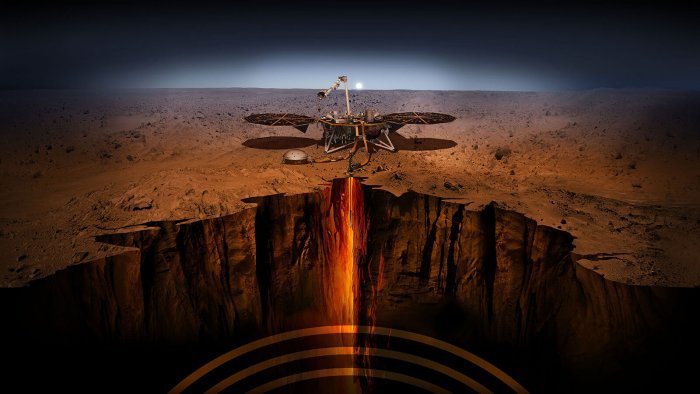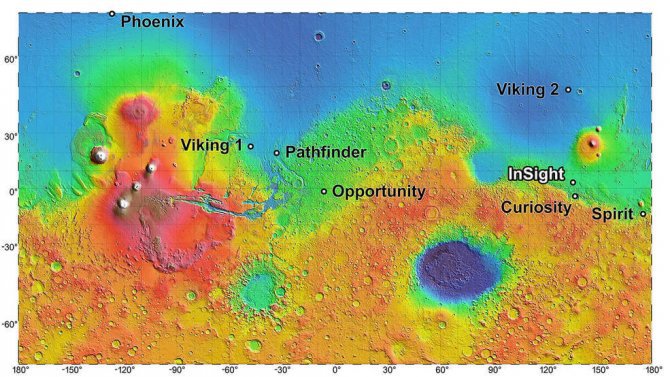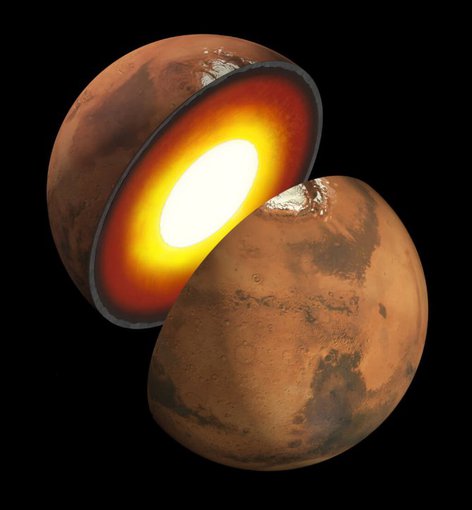
Nov. 12, 2018
Research Highlight
Probing The Insides of Mars to Learn How Rocky Planets Are Formed
InSight is set to touch down on Mars on November 26, 2018.

An artist illustration of the InSight lander on Mars. InSight, short for Interior Exploration using Seismic Investigations, Geodesy and Heat Transport, is designed to look for tectonic activity and meteorite impacts, study how much heat is still flowing through the planet, and track Mars’ wobble as it orbits the sun. While InSight is a Mars mission, it will help answer key questions about the formation of the other rocky planets of the solar system and exoplanets beyond.Image credit: NASA/JPL-Caltech.
In the known history of our 4.5-billion-year-old solar system, the insides of but one planet have been explored and studied. While there’s a lot left to know about the crust, the mantle and the core of the Earth, there is a large and vibrant field dedicated to that learning.
Sometime next month, an extensive survey of the insides of a second solar system planet will begin. That planet is Mars and, assuming safe arrival, the work will start after the InSight lander touches down on November 26.
This is not a mission that will produce dazzling images and headlines about the search for life on Mars. But in terms of the hard science it is designed to perform, InSight has the potential to tell us an enormous amount about the makeup of Mars, how it formed, and possibly why is it but one-third the size of its terrestrial cousins, Earth and Venus.
“We know a lot about the surface of Mars, we know a lot about its atmosphere and even about its ionosphere,” says Bruce Banerdt, the mission’s principal investigator, in a NASA video. “But we don’t know very much about what goes on a mile below the surface, much less 2,000 miles below the surface.”
The goal of InSight is to fill that knowledge gap, helping NASA map out the deep structure of Mars. And along the way, learn about the inferred formation and interiors of exoplanets, too.

Equatorial Mars and the InSight landing site, with noting of other sites.Image credit: NASA.
The lander will touch down at Elysium Planitia, a flat expanse due north of the Curiosity landing site. The destination was selected because it is about as safe as a Mars landing site could be, and InSight did not need to be a more complex site with a compelling surface to explore.
“While I’m looking forward to those first images from the surface, I am even more eager to see the first data sets revealing what is happening deep below our landing pads.” Barerdt said. “The beauty of this mission is happening below the surface. Elysium Planitia is perfect.”
By studying the size, thickness, density and overall structure of the Martian core, mantle and crust, as well as the rate at which heat escapes from the planet’s interior, the InSight mission will provide glimpses into the evolutionary processes of all of the rocky planets in the inner solar system.
That’s because in terms of fundamental processes that shape planetary formation, Mars is an ideal subject.
It is big enough to have undergone the earliest internal heating and differentiation (separation of the crust, mantle and core) processes that shaped the terrestrial planets (Earth, Venus, Mercury, our moon), but small enough to have retained the signature of those processes over the next four billion years.
So Mars may contain the most in-depth and accurate record in the solar system of these processes. And because Mars has been less geologically active than the Earth — it does not have plate tectonics, for example — it has retains a more complete evolutionary record in its own basic planetary building blocks. In terms of deep planet geophysics, it is often described as something of a fossil.

An artist rendering of the insides of rocky body like Mars. The manner in which the different layers form and differentiate is seen as a central factor in whether the planet can become habitable.Image credit: NASA.
By using geophysical instruments like those used on Earth, InSight will measure the fingerprints of the processes of terrestrial planet formation, as well as measuring the planet’s “vital signs.” They include the “pulse” (seismology), “temperature” (heat flow probe), and “reflexes” (precision tracking).
One promising way InSight will peer into the Martian interior is by studying motion underground — what we know as marsquakes.
NASA has not attempted to do this kind of science since the Viking mission. Both Viking landers had their seismometers on top of the spacecraft, where they produced noisy data. InSight’s seismometer will be placed directly on the Martian surface, which will provide much cleaner data.
As described by the agency, “NASA have seen a lot of evidence suggesting Mars has quakes. But unlike quakes on Earth, which are mostly caused by tectonic plates moving around, marsquakes would be caused by other types of tectonic activity, such as volcanism and cracks forming in the planet’s crust.
“In addition, meteor impacts can create seismic waves, which InSight will try to detect.
“Each marsquake would be like a flashbulb that illuminates the structure of the planet’s interior. By studying how seismic waves pass through the different layers of the planet (the crust, mantle and core), scientists can deduce the depths of these layers and what they’re made of. In this way, seismology is like taking an X-ray of the interior of Mars.”

The InSight seismometer, developed by European partners and JPL, consists of a total of six seismic sensors that record the vibrations of the Martian soil in three directions in space and at two different frequency ranges. ges allows them to be mathematically combined into a single extremely broadband seismometer. In order to protect the seismometer against wind and strong temperature fluctuations, a protective dome (Wind and Thermal Shield, WTS) will be placed over it.Image credit: German Aerospace Center.
Scientists think it’s likely they’ll see between a dozen and a hundred marsquakes over the course of two Earth years. The quakes are likely to be no bigger than a 6.0 on the Richter scale, which would be plenty of energy for revealing secrets about the planet’s interior.
Another area of scientific interest involves whether or not the core of Mars is liquid. InSight’s Rotation and Interior Structure Experiment, RISE, will help answer that question by tracking the location of the lander to determine just how much Mars’ North Pole wobbles as it orbits the sun.
These observations will provide information on the size of Mars’ iron-rich core and will help determine whether the core is liquid. It will also help determine which other elements, besides iron, may be present.
The InSight science effort includes a self-hammering heat probe that will burrow down to 16 feet into the Martian soil and will for the first time measure the heat flow from the planet’s interior. Combining the rate of heat flow with other InSight data will reveal how energy within the planet drives changes on the surface.
This is especially important in trying to understand the presence and size of some of the solar system’s largest shield volcanoes in the solar system, a region known as Tharsis Mons. Heat escaping from deep within the planet drives the formation of these types of features, as well as many others on rocky planets.

The Tharsis region of Mars has some of the largest volcanoes in the solar system. They include Olympus Mons, which is 375 miles in diameter and as much as 16 miles high.Image credit: U.S. Geological Survey.
InSight is not an astrobiology mission — no searching for life beyond Earth.
But it definitely is part of the process by which scientists will learn what planet formation and the dynamics of their interiors says about whether a planet can be home to life.